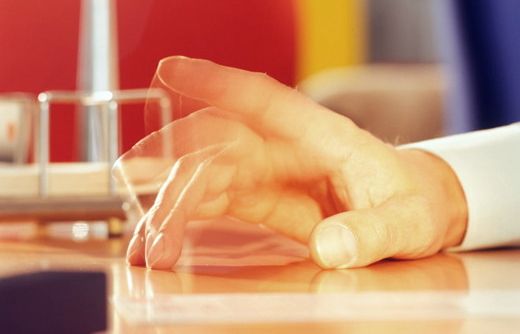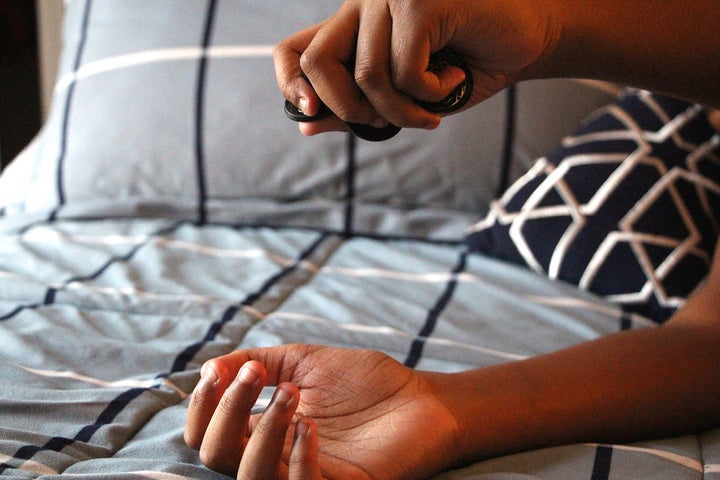
For those who are unfamiliar with the term stimming, it is a term many in the autism community use to refer to self-stimulatory behavior which is a specific behavior like rocking, watching objects spin or fall, squeezing, swinging, flapping hands, or repeating words and phrases. This involuntary behavior helps people with autism manage emotions, handle sensory overload, or focus their thoughts.

If you think about it, most of us, from time to time, do typical or what we might call “normal” stimming-type behaviors like drumming our fingers on a desk; wiggling or tapping a pencil; pacing back and forth; bouncing a knee up and down; twirling a lock of hair; or even humming. The difference between “normal” stimming and autistic stimming, is how often it occurs and what kind of stim activity is chosen.

My personal belief is, if the stimming isn’t a distraction, and doesn’t cause harm to the one stimming or to others, then it can be a reasonable, healthy coping mechanism for that individual. But if it does become disruptive or dangerous, then the stimming needs to be modified – which is easier said than done.
Before Chase was diagnosed with autism, one of his favorite things to do was to roll his Hot Wheels cars back and forth and just watch the wheels spin. After the autism diagnosis, Chase started receiving help to this behavior. It took a while to re-train him to play with the cars appropriately, but that didn’t change the desire for him to stim. He just went from watching wheels spin to watching objects fall. We’d go to the beach and he would sit and pick up sand and watch it fall. On the playground, he’d pick up the bark and watch it fall, and in the classroom he would use his pencils or crayons. His stimming was more frequent during those times when he was still struggling with speech, comprehension, and social interactions – all major sources of stress, which is one of the triggers for stimming. As Chase’s speech, comprehension, and socialization improved, his stimming decreased, but it remained a regular fixture in his life.

He would stim when he was bored, and in class when he didn’t comprehend or understand the relevance of what the teacher was discussing. He would stim even when his surroundings were calm - no confusion or stressors in the picture at all. This puzzled me and made me want to peek inside his head to see what was going on in that mind of his. He would sometimes make noises like he was playing out a scene or something. At the time, he still didn’t have the language to express to me what was going on in his head. Fast forward to Chase at 9 years old, and by then I knew that stimming is a part of who Chase is, and for the most part, it was okay. But there were still a couple of modifications that I felt were necessary for him to make.
First, I needed to limit his stimming to one, simple multi-piece set that would be appropriate for the activity. Chase’s grandfather, Papa, came to the rescue and bought him a small bag of shiny, plastic, gold St. Patrick’s Day coins about the size of 50 cent pieces. Chase used those coins for over 5 years – all the gold had worn off and most of the pieces had gone missing before we replaced them with his current set of coins.

The second thing I had to do was get him to limit his stimming to a private space. This took quite a while, and included several conversations, and role playing about social perceptions and being aware of his surroundings.

When Chase’s language skills had progressed, I asked him what was going on in his mind when he was stimming. “Chase, what are you thinking about when you’re playing with your coins?” His response was simple, yet poignant. He said, “Imagination.”

With that one word, it all made sense. “What are you imagining?” I asked. He said, “I’m thinking about my recipes and the movies that I want to make.” Then I asked, “What about when you’re making those noises - what are you thinking about?” He replied, “Sometimes, I’m thinking about battles, like The Hulk, and he’s fighting with Iron Man. It helps me be creative.”
Essentially, Chase’s coins are his “executive pacifier,” and his stimming is no different than a person sitting at a desk watching the spheres of Newton’s Cradle swing back and forth, while problem-solving or mapping out the next big vision.
